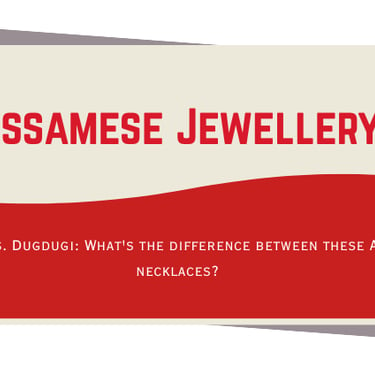Dholbiri vs. Dugdugi: What's the difference between these Assamese necklaces?
ASSAMESE TRADITIONAL JEWELLERY
Kasturi Gogoi


Dholbiri and Dugdugi are two of the most recognizable traditional Assamese necklaces, each carrying its own story, symbolism, and charm. While both are deeply rooted in Assamese culture, their designs and meanings differ. The Dholbiri takes inspiration from the dhol, a traditional Assamese drum used in Bihu celebrations. It’s typically shaped like a miniature drum, representing rhythm, festivity, and energy. In contrast, the Dugdugi is heart-shaped, symbolizing love, grace, and feminine beauty. Both are handcrafted in gold or silver and often adorned with red and black enamel (mina) work. Assamese women wear them during Bihu, weddings, and cultural functions as symbols of pride and heritage. Though different in form, Dholbiri and Dugdugi share the same spirit — they both celebrate Assamese identity through music, emotion, and artistry.
Dholbiri vs. Dugdugi: What’s the Difference Between These Assamese Necklaces?
Introduction
Assamese jewellery is known for blending tradition, artistry, and symbolism in unique ways. Among its many stunning designs, Dholbiri and Dugdugi stand out as two classic necklaces often worn during Bihu festivals and traditional ceremonies. Though they may seem similar at first glance, these two ornaments differ in design, inspiration, and meaning — each representing a distinct aspect of Assamese culture.
Origin and Cultural Background
Both Dholbiri and Dugdugi trace their roots back to Assam’s ancient goldsmithing traditions, which flourished during the Ahom dynasty. Local artisans (sonars) crafted these pieces using gold or silver, combining natural and cultural symbols to reflect Assamese identity.
Dholbiri emerged as a tribute to music and festivity, inspired by the traditional dhol drum played during Bihu celebrations.
Dugdugi, on the other hand, was designed as a symbol of love and charm, often gifted to brides or women during special occasions.
What is Dholbiri?
The Dholbiri necklace draws inspiration from the dhol — a traditional percussion instrument central to Assamese folk music.
Key Features:
Shape: Cylindrical or barrel-shaped pendant resembling a drum.
Symbolism: Represents energy, rhythm, and the heartbeat of Assamese festivities.
Design Details:
Made of gold or silver.
Decorated with red and black enamel (mina) work.
Sometimes features tiny beads or filigree patterns.
When Worn: Commonly worn during Bihu, cultural dance performances, and festive events.
The Dholbiri celebrates the joy of music and togetherness that defines Assamese culture.
What is Dugdugi?
The Dugdugi is one of the most graceful and feminine designs in Assamese jewellery.
Key Features:
Shape: Heart-shaped pendant or bead, often slightly rounded.
Symbolism: Represents love, beauty, and emotional connection.
Design Details:
Made in gold or silver with red and black mina detailing.
Sometimes includes small dangling elements for a softer look.
Traditionally strung together as a choker-style necklace or worn as a single pendant.
When Worn: Popular among women during weddings, festivals, and family functions.
The Dugdugi is seen as a symbol of affection and inner beauty — often passed down as a cherished heirloom.
Design and Craftsmanship Comparison
FeatureDholbiriDugdugiShapeDrum-shaped (inspired by dhol)Heart-shapedSymbolismRhythm, energy, festivityLove, beauty, emotionMaterialGold or silver with mina workGold or silver with mina workCultural ConnectionLinked to Bihu music and folk instrumentsLinked to femininity and affectionOccasionsBihu festivals, cultural eventsWeddings, family celebrationsStyleBold, festive, rhythmicElegant, delicate, romantic
Artistic Techniques
Both necklaces use the traditional Assamese mina or enamel technique, usually in shades of red and black.
Artisans handcraft each piece with intricate carvings and smooth polishing.
The pendants are often strung on fine chains or beaded threads, creating a balance of simplicity and beauty.
These traditional methods keep Assamese jewellery authentic and timeless.
Cultural and Emotional Symbolism
Dholbiri: Embodies the rhythm of Assamese life, echoing the sound of Bihu Dhol that brings people together.
Dugdugi: Reflects tenderness and love, often associated with affection between couples or family members.
Both pieces carry emotional weight, linking the wearer to Assamese tradition, celebration, and womanhood.
Modern Adaptations
Today’s jewellers have reimagined Dholbiri and Dugdugi for contemporary wear:
Lighter, smaller versions for casual and daily use.
Fusion pieces combining Assamese motifs with modern aesthetics.
Silver, brass, and imitation versions that make these designs more affordable and accessible.
Despite modernization, both ornaments continue to symbolize Assamese heritage and identity.
FAQs
1. What is the main difference between Dholbiri and Dugdugi?
The Dholbiri is drum-shaped and symbolizes festivity and rhythm, while the Dugdugi is heart-shaped and represents love and beauty.
2. When are these necklaces typically worn?
Dholbiri is often worn during Bihu and cultural performances; Dugdugi is popular at weddings and festive occasions.
3. What materials are used to make them?
Both are traditionally crafted from gold or silver and decorated with red and black mina enamel.
4. Can men wear Dholbiri or Dugdugi?
Traditionally, these are women’s ornaments, though some modern adaptations are unisex.
5. Are Dholbiri and Dugdugi available outside Assam?
Yes, many Assamese jewellers and online stores sell authentic and imitation versions across India and globally.
Conclusion
Dholbiri and Dugdugi may differ in design and meaning, but together they showcase the soul of Assamese jewellery — where art, emotion, and culture intertwine. The Dholbiri celebrates rhythm and festivity, while the Dugdugi reflects love and grace. Both remind us of Assam’s rich craftsmanship and timeless beauty, carrying forward traditions that continue to inspire new generations of jewellery lovers.